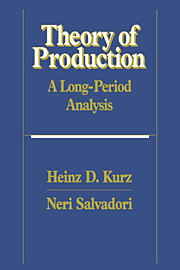Book contents
- Frontmatter
- Contents
- Preface
- A reader's guide
- 1 Free competition and long-period positions
- 2 A one-commodity model
- 3 Two-commodity models
- 4 Models with any number of commodities
- 5 Choice of technique
- 6 Alternative descriptions of a technique
- 7 Fixed capital
- 8 Joint production
- 9 Jointly utilized machines
- 10 Land
- 11 Persistent wage and profit rate differentials
- 12 On limits to the long-period method
- 13 Production as a circular flow and the concept of surplus
- 14 The neoclassical theory of distribution and the problem of capital
- 15 On some alternative theories of distribution
- Mathematical appendix
- References
- Name index
- Subject index
12 - On limits to the long-period method
Published online by Cambridge University Press: 06 January 2010
- Frontmatter
- Contents
- Preface
- A reader's guide
- 1 Free competition and long-period positions
- 2 A one-commodity model
- 3 Two-commodity models
- 4 Models with any number of commodities
- 5 Choice of technique
- 6 Alternative descriptions of a technique
- 7 Fixed capital
- 8 Joint production
- 9 Jointly utilized machines
- 10 Land
- 11 Persistent wage and profit rate differentials
- 12 On limits to the long-period method
- 13 Production as a circular flow and the concept of surplus
- 14 The neoclassical theory of distribution and the problem of capital
- 15 On some alternative theories of distribution
- Mathematical appendix
- References
- Name index
- Subject index
Summary
The analysis presented so far has been exclusively concerned with the problem of the existence of long-period positions of the economic system characterized by “stationary” prices, with the price of a commodity obtained as an output at the end of the production period being the same as the price of that commodity used as an input at the beginning of that period. It has been indicated repeatedly, though, commencing with Chapter 1, that in order to exhibit this property, an economic system has to fulfill certain requirements. For example, technical innovation must be set aside and in the presence of nonconstant returns to scale the system must be stationary. Otherwise, relative prices would have to change.
The main object of this chapter is to introduce the reader to some important cases in which some or all prices will of necessity change over time. Section 1 takes as a starting point the analysis of self-reproducing non-basics in Sections 3 and 6 of Chapter 3 and in Section 4 of Chapter 5. The earlier analysis focused on the problem of the existence, or lack thereof, of a long-period position in the case in which some self-reproducing non-basic cannot be produced, given the level of the general rate of profit. In contradistinction, in this chapter emphasis will be on the determination of the short-period price of that non-basic, a given amount of which is taken to be available from previous periods of production, and on whether or not it will be produced in the short period.
- Type
- Chapter
- Information
- Theory of ProductionA Long-Period Analysis, pp. 339 - 378Publisher: Cambridge University PressPrint publication year: 1995



